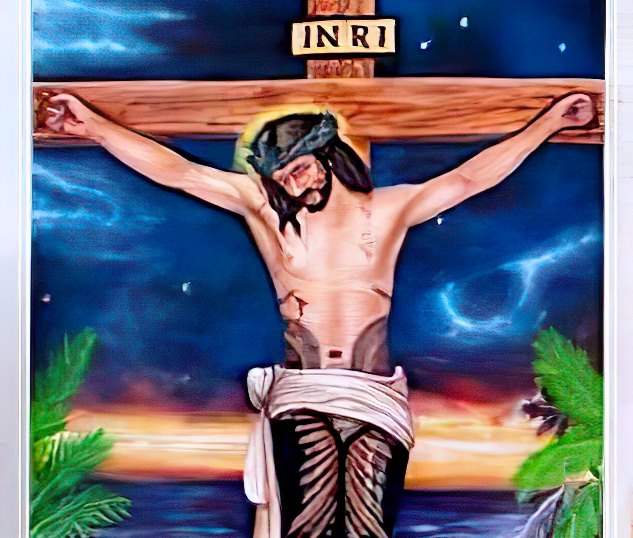Latest
VIEWPOINT: A Tattooed Jesus?

By Daniel Pouesi
A recent Samoa Observer story about a young artist who painted the crucified Jesus with a traditional tattoo caught my attention. The writer notes the painting “gathered traction on social media” and drew ire from viewers—with some calling it “disrespectful.”
The young man, according to the story’s lede, didn’t think so. I didn’t read the young man’s reason for depicting Jesus with a Samoan sogaimiti.
Whatever it is, it can’t be far off from what our Pacific Island “contextual theologians” have been teaching and promoting in writing for years. A former principal of an island seminary said in an interview that Jesus should have a tattoo (tatau) to show His role as servant—taule’ale’a.
Another (a man I regard with respect) entertained the idea of utilizing the tattoo as “initiation” into the church. But the Christian church already has an ordinance that serves the purpose—baptism. It is through baptism a person is admitted into church fellowship.
The Crucified Jesus isn’t a new subject for artists. For centuries, artists have etched and painted the crucifixion on catacombs, scrolls, metal and church ceilings. Most early painters portrayed Jesus reverently. The crucified Savior as depicted by master painters like Francisco Goya still move viewers with their sheer intensity.
Sadly, as of late, many have chosen the contrary road—caricaturing, mocking, ridiculing, or misrepresenting Jesus in works of art. So we now have a Black Jesus, a Native American one, a Gay Jesus, and (in the media) a pathetically weak and less-than-perfect one.
As nations (the US is a case in point) lean more and more into radical leftist ideology, Christians can expect to see a Woke or transgender Jesus soon.
For followers of Christ, such blasphemous misrepresentations can cut deeply. In his book “Henry Martyn: Confessor of the Faith”, author Constance E. Padwick quotes an exchange between the missionary Martyn and a Muslim friend (Mirza Ali) who once invited the former to dinner. Over dinner, Ali described for Martyn a painting showing Jesus bowing down to Mohammed. Martyn tells what happened next: “I was cut to the soul at this blasphemy. Mirza Seid Ali perceived that I was considerably disordered and asked what it was that was so offensive? I told him ‘I could not endure existence if Jesus was not glorified; it would be hell to me if He were to be always thus dishonored.’ He was astonished and again asked ‘Why?’ ‘If anyone pluck out your eyes,’ I replied, ‘there is no saying why you feel pain; it is feeling. It is because I am one with Christ that I am thus dreadfully wounded.’”

Perhaps for those who were offended by the young Samoan’s painting, depicting Jesus as anything other than what the Bible has revealed about Him is to dishonor Him. They may well side with Martyn: “It is because I am one with Christ that I am thus dreadfully wounded.”
For whatever it’s worth, the young man’s painting did reveal a truth—Jesus WAS crucified. He died a common criminal’s death—nailed to a cross by sinful man. But by casting the Lord as a Samoan with a tattoo, the young artist (perhaps out of a sense of nationalism) perverted Jesus’ claim He is Jewish. He made this perfectly clear in His brief encounter with a Samaritan woman: “You Samaritans worship what you do not know; we worship what we do know, for salvation is from the Jews.”
This, I suppose, is what bothered some about the young man’s painting. It presents Jesus as a Samoan who, before shedding his blood for the remission of sin, bled under a tattooist’s needles. Strangely, in a world where people are obsessed with race, ethnicity, and Identity Politics, it is troubling so many have no problem imposing on or assigning to Jesus (and ONLY Jesus) an identity that isn’t His.
“To our young artists (and writers), please don’t waste your God-given talent and gifts on “contextual” nonsense. Use them to glorify God and edify your viewers!”Many in this crowd get offended or go ballistic when others misidentify their “preferred gender or pronouns”, sexual orientation or “assigned” ethnicity; who hasn’t heard a youth loudly proclaiming, “I am proud to be Samoan.” And yet, the same have no qualms about misidentifying Jesus.
Liberal media goes so far as to portray Him as a weakling or a pathetic human struggling with temptation. Whatever their motives, God only knows. There is one thing we can say with certainty: no painting of the Crucified Jesus comes close to showing what He actually went through on the day He was crucified.
In the garden of Gethsemane, Jesus experienced what the medical profession calls hematidrosis—He sweated blood. In an interview with former atheist Lee Strobel, noted Medical Doctor Alexander Metherell notes, before the flogging, hematidrosis would have rendered Jesus’ skin “extremely fragile” and sensitive. Then came the flogging—a terribly brutal affair. It consisted of thirty-nine (plus one) lashes but “frequently were a lot more….depending on the mood of the soldier.”
The whip the soldier used was leather thongs intertwined with metal balls and sharp bones. When the whip descended on Jesus’ back, the metal balls produced deep bruises and contusions. The bones ripped open His flesh. Metherell describes the aftereffect: “The back would be so shredded that part of the spine was sometimes exposed by the deep cuts. The whipping would have gone all the way from the shoulders down to the back, the buttocks, and the back of the legs.” A physician who researched Roman scourging adds: “As the flogging continued, the laceration would tear into the underlying skeletal muscles and produce quivering ribbons of bleeding flesh.” From the ancient writing instrument of third-century historian Eusebius comes the following: “The sufferers’ veins were laid bare, and the very muscles, sinews, and bowels of the victim were open to exposure.”
Few survived Roman flogging. If, by some miracle, they did, they went through what physicians called Hypovolemic Shock. That’s unadulterated suffering produced from loss of blood. Four things happen to a person experiencing Hypovolemic Shock. First, the heart beat accelerates to try and pump to the body blood that no longer exists. Blood pressure drops, resulting in the person fainting or collapsing. The kidneys stop producing urine to maintain what volume remains in the body. And finally, the person becomes grossly dehydrated and craves fluid to replace the lost blood.
All of these happened to Jesus. The worst was to come. At Golgotha, He was laid (presumably naked) on the ground and His hands were nailed to the crossbeam (patibulum). The nails, according to Metherell and others, were spikes of five to seven inches long honed to a sharp point. They were driven through Jesus’ wrists locking His hands. The spike would have gone through the part of His wrists where the median nerves run producing terrific pain. Metherell describes the pain as that which one feels when one bangs one’s elbow—except it’s multiplied manyfold, as if someone had taken a pair of pliers and squeezed and crushed the nerves. The pain was absolutely unbearable and indescribable they had to invent a word for it—excruciating.” Excruciating means “out of the cross.”
After Jesus was nailed to the crossbeam, He was hoisted to the vertical stake. Thus suspended, spikes were driven through His feet (some say ankles based on archaeological findings). The feet or ankles would have been crushed, again, producing unimaginable pain. On the cross, the stress would have been on our Lord’s arms which were immediately stretched some six inches. His shoulders were thrown out of their sockets. Thus the psalmist writes in Psalm 22: “My bones are out of joint.”
Death on the cross is, Metherell notes, essentially an agonizingly slow death by a process called asphyxiation. Because of the pressure on the muscles and diaphragm, Jesus’ chest would have been locked in an inhaled position. In order to breath, He would have to push up with His toes so the tension on the muscle could be relieved. As His breathing slows down, He would have gone into respiratory acidosis. Carbon dioxide in the blood dissolves into carbonic acid increasing the acidity of the blood. This leads to irregular heartbeats. It was, at this moment, Methedrell surmises, Jesus (about to go into cardiac arrest) called out, “Father, into Your hands I commit My spirit.”
No genuine Christian can read the gospel accounts of Jesus’ crucifixion and not choke up. As a Christian, I understand the outrage some felt after viewing the young Samoan artist’s painting. Any Jesus that departs from the gospel accounts isn’t Jesus at all. If he’s gay, bi-sexual, black, red, or brown with a tattoo, he is an impostor—a figment of a person’s imagination—in a nutshell, it’s a Jesus created in man’s image.
In fairness to the young artist, we who profess to be Christians must also be outraged at ourselves! Perhaps we have not maligned and misrepresented our Lord in paintings. But we have done so with habitual sinning. Tragically, as the author of Hebrews writes: “It is impossible for those who have once been enlightened, who have tasted the heavenly gift, who have shared in the Holy Spirit, who have tasted the goodness of the word of God and the powers of the coming age and who have fallen away, to be brought back to repentance. To their loss they are crucifying the Son of God all over again and subjecting him to public disgrace.”
We see outrage in the Apostle Paul when he challenged certain individuals (Epicureans and Stoics) on Mars Hills (Acts 17). In this city of great learning and pleasure, surrounded by sculptured idols, Paul could not help himself. Doctor Luke said Paul was “provoked.” And he spoke out. Using the idolaters’ idol dedicated “to an unknown God”, he told his listeners about the true God. To Epicurean and Stoic philosophers alike, Paul’s teachings was strange. But his message was simple—REPENT. “Being then God’s offspring, we ought not to think that the divine being is like gold or silver or stone, an image formed by the art and imagination of man” (my emphasis).
The apostle concluded: “In the past God overlooked such ignorance, but now he commands all people everywhere to repent. For He has set a day when He will judge the world with justice by the Man He has appointed. He has given proof of this to everyone by raising Him from the dead” (my emphasis).
Why repent? Because, as Paul writes, God has set a day when Jesus will judge the world. He will judge all based on the things they did on earth. And as the writer of Hebrews reminds us: “It is a dreadful thing to fall into the hands of the living God.”
Turning the mirror on ourselves is a great reminder of the continual and personal repentance that is required of the believer. To our young artists (and writers), please don’t waste your God-given talent and gifts on “contextual” nonsense. Use them to glorify God and edify your viewers! God bless!



















